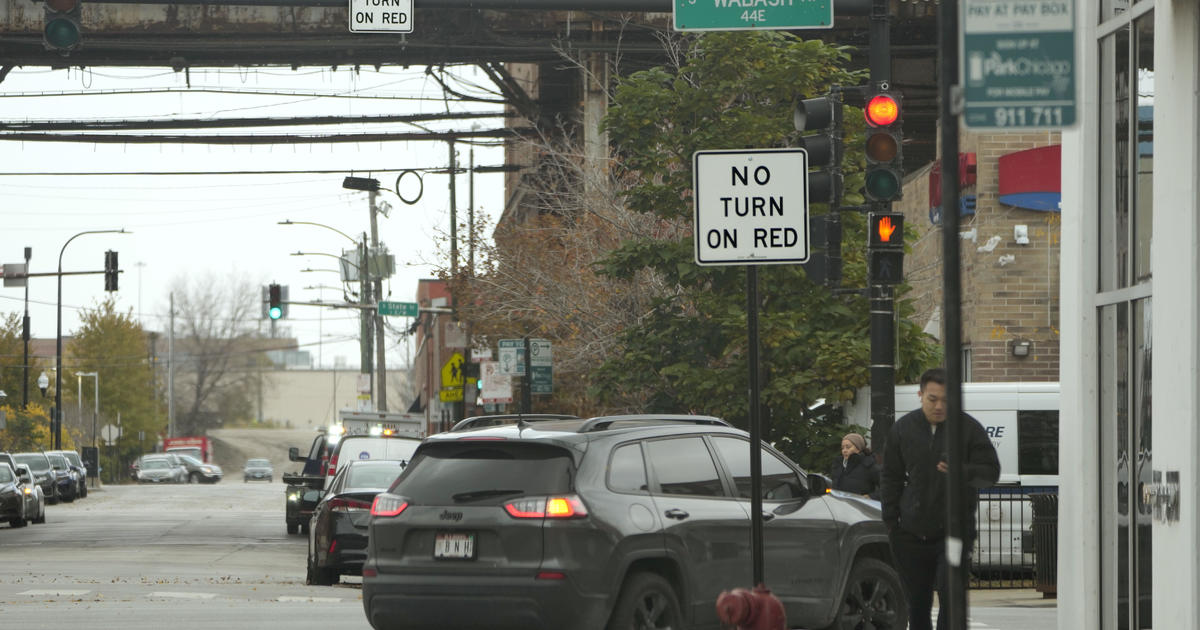Sophee Langerman was on her way to a bicycle safety rally in Chicago’s Lakeview neighborhood in June when a car turning right rolled through a red light and slammed into her bike, which she was walking off the curb and into the crosswalk.
The car was moving slowly enough that Langerman escaped serious injury, but the bicycle required extensive repairs. To Langerman, it’s another argument for ending a practice that almost all U.S. cities have embraced for decades: the legal prerogative for a driver to turn right after stopping at a red light.
A dramatic rise in accidents killing or injuring pedestrians and bicyclists has led to a myriad of policy and infrastructure changes, but moves to ban right on red have drawn some of the most intense sentiments on both sides.
Washington, D.C.'s City Council last year approved a right-on-red ban that takes effect in 2025. New Chicago Mayor Brandon Johnson’s transition plan called for “restricting right turns on red,” but his administration hasn’t provided specifics. The college town of Ann Arbor, Michigan, now prohibits right turns at red lights in the downtown area.



There are many reasons why it is bad for everyone, but I will cite a few specifics.
To start with, in the absence of good alternatives, vast majority of pedestrians and cyclists would also be regular drivers. The only exceptions would be people who are too poor to avoid a car. If the drivers and the walkers are the same people then the people who regularly walk still suffer from slowed traffic because they still take the car for some trips.
Poor mobility for cars also translates to increased cost of living. Most businesses rely upon vehicle transport in some way or another and the increased cost of doing business gets passed onto the consumer.
In addition, the existence of high throughput streets with higher speed limits tends to concentrate traffic into specific predictable areas. When you reduce the throughput of those areas, traffic gets distributed onto more roads. The result is that cyclists and pedestrians are less able to avoid cars with strategic route planning.
To clarify, this isn’t every street in the USA, it’s only major thoroughfares. Most side streets in US cities have a 25-30 mph speed limit. In a world with well designed bike infrastructure we would have dedicated paths separated from traffic so you don’t have to share the road with fast moving cars.
Nope, that’s backwards. Poor mobility for cars comes from higher-density development, which is also efficient development because you don’t have to spend huge amounts of money building parking. Getting rid of the cars is the thing that lowers the costs!
Futhermore, getting rid of the cars is also the thing that enables walking/biking/transit to be viable (because there’s physically less distance to cover, since you don’t have to cross a wasteland of pavement), which also lowers cost of living.
The bottom line is that if you build to accommodate cars, you will never have walkability. It’s geometrically impossible.
Distributing traffic onto more (uniformly-slow) streets means that cyclists and pedestrians have less need to avoid cars with strategic route planning because slow-moving cars aren’t nearly as much of a danger to begin with.
Did you actually read anything I have written?
The point is that simply lowering speed limits as the primary lever to improve quality of life isn’t useful. It does nothing to reallocate that space in a beneficial way.
I’m literally arguing in favor of reducing space for cars for more pedestrian, cycling and transit infrastructure
Guess what? The city is already built. I agree with you.
The question is how to move forward and slapping lower speed limits on everything isn’t the solution. You need to actually spend money on revamping the infrastructure so there are meaningful alternatives. Try to read more and jump to conclusions less.
You’re literally arguing for going about it ass-backwards in a way doomed to failure, which is a disingenuous, passive-aggressive way of opposing it.
In order to actually spend money on bike/ped/transit, the politicians have to allocate it for that purpose. That doesn’t happen unless the public is made to hate driving first!
I’m sorry but most of what you say doesn’t make any sense. Why would making it easier and faster to drive encourage cycling and walking?
Let me address your points in turn:
Yes, slowing car traffic makes car travel worse. That’s the point. Cars are massively prioritized right now.
Cars are a cost of living disaster. The US and Canada spend the most on transportation costs in the world. The US actually spends more public tax dollars on transportation because car infrastructure is the least efficient and most expensive to build. Cars themselves are the biggest household expense after housing. Businesses also thrive in car free environments. In Europe, businesses know this and fight to remove car infrastructure. Ever wonder why the most economically vibrant areas are the least car dependent? The US and Canada are brainwashed.
The solution to cars driving on cycling routes is to lower the speed limit even more on those routes. Like I said, in Canada many cycling routes are 18 mph. Most drivers go even slower on cycling prioritized routes. It’s mind boggling to think it would be safer if cars could go faster.
I’ve lived for many years in both countries. The US drives way faster and is much more dangerous, despite similar looking streets. In most other developed countries, traffic accident rates are falling to record lows. The US is a tragic outlier.. Prioritizing “traffic flow” is the heart of the problem.
You probably meant “car infrastructure is the least efficient” or “car infrastructure is the most inefficient”
yes, typo. Corrected.